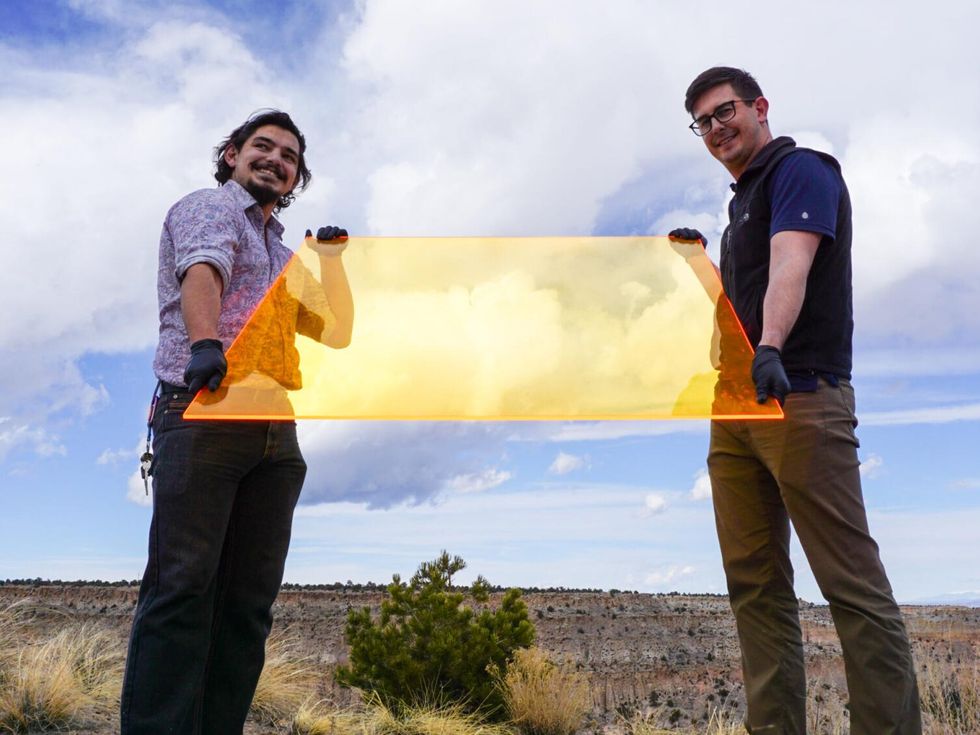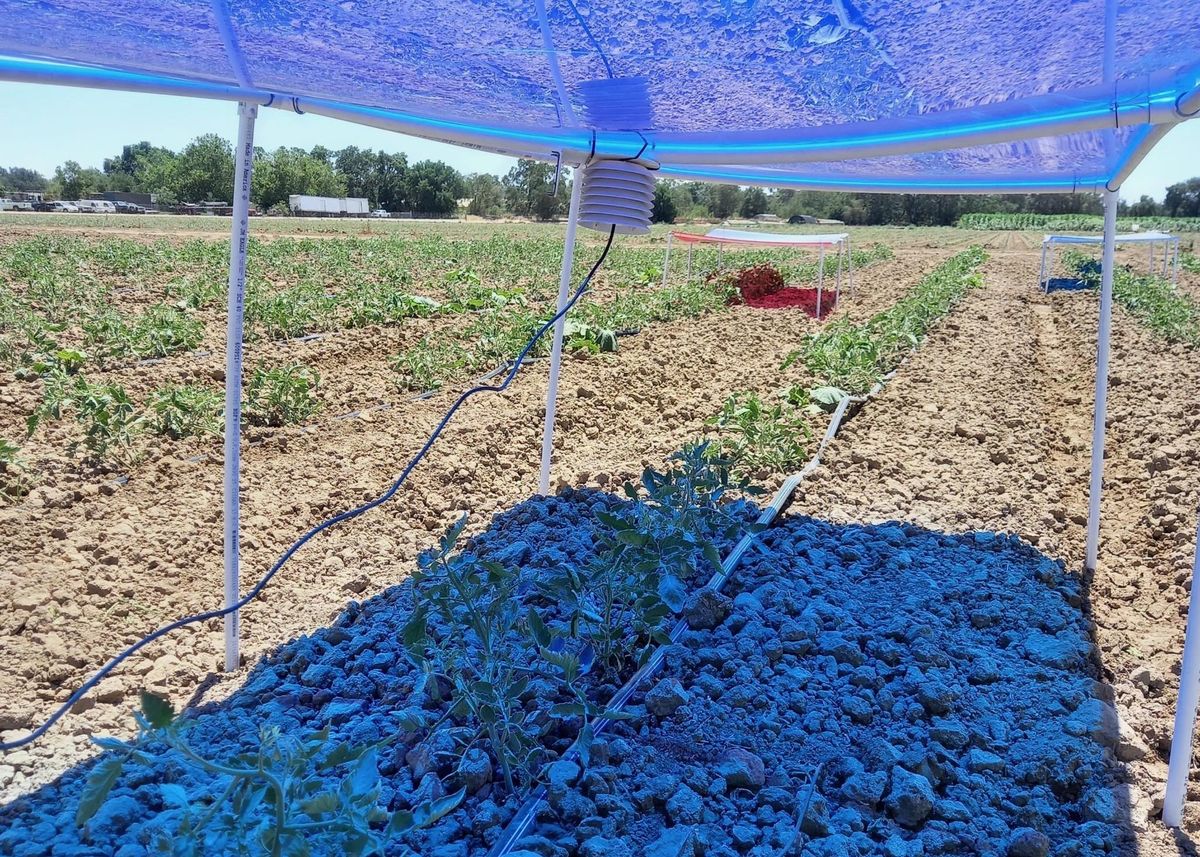There is no unused arable land on a planet that’s already struggling to support a human population that cleared 8 billion last month, and where roughly 1 million plants and animals are threatened with extinction. The pressure is palpable. In Montreal this week, activists and diplomats are negotiating a biodiversity treaty in an effort to reserve 30 percent of Earth’s surface for wildlife. This increasingly zero-sum competition for resources is what inspired University of California, Davis soil biophysics expert Majdi Abou Najm to start working on a land- and water-saving rethink of both solar energy and agriculture.
Instead of dedicating land exclusively for solar farms, Abou Najm is exploring how translucent photovoltaic panels erected over farm fields can be tuned to absorb and transmit optimal bands of sunlight to generate substantial power without stunting the development of crops growing below. In certain cases, the panels might even improve yields.
“The U.N. projects that humanity will need on the order of 60 percent more food, 40 percent more water, and 50 percent more energy by 2050. We are at a stage where fixing one issue at a time won’t work. We need to optimize,” says Abou Najm, who is a professor at the UC Davis Department of Land, Air, and Water Resources.
Efforts to combine solar technology and farming — known as agrivoltaics — have been underway for a decade. In the past several years, some researchers have begun exploring the use of PV panels that allow some light through, rather than simply capturing it all and casting shade. They have hinted at a fantastic opportunity: boosting the system’s net efficiency and profitability by generating power with the higher-energy blue side of the solar spectrum, and letting through the redder light that many plants prefer.
It’s an actionable opportunity, thanks to the growing availability of tunable translucent solar panels produced from semiconductor films or particles. Researchers at the University of Arizona and several Israeli institutes, for example, are studying agrivoltaics using organic PV films produced by the Armor Group, based in Nantes, France. Meanwhile, quantum-dot developer UbiQD, based in Los Alamos, N.M., has used its semiconductor particles to also produce transparent PV.
Abou Najm’s contribution, along with hydrologist Matteo Camporese of the University of Padova, in Italy, is the first comprehensive growth model that can predict the spectral split that will maximize land and water efficiency for any combination of crop, climate, and solar panel.
It’s a complex problem with nonlinear interactions between key components, says Abou Najm. Optimization by trial and error would slow the growing field, he adds. “This is the first model that can look at all of those interactions together and solve them at the same time, in a set of equations.” The model was published last month in Earth’s Future, a journal of the American Geophysical Union.
The researchers assessed their model by simulating agrivoltaic cultivation of lettuce, basil, and strawberries. They confirmed that growing under redder light tends to reduce water use and boost growth, but found that passing some bluer light through yields optimal results.
More recent fieldwork with UC Davis agricultural engineering professor Andre Daccache is adding validation. Preliminary experiments, using colored filters as a stand-in for translucent PV, measured cultivation of tomatoes under a variety of conditions. The team is currently analyzing reams of data from the sensors that gathered data during the trial.
Optimized agrivoltaics might be particularly important in arid breadbaskets such as California’s Central Valley, which delivers about one-fourth of the U.S. food supply. And farmers are keen. Abou Najm says local farmers who had showed zero interest in agrivoltaics five years ago are now eager to learn more. He credits years of drought, as well as increasingly destructive heat waves such as one this September that delivered temperatures of 43 °C to 46 °C for a week in California.
“That was really an eye opener. Growers could see how much sun can also be a disturbing force. They’re seeing the effect of heat stress and heat burns on their crop yields, and the cost of water associated with that heat,” says Abou Najm. He predicts that agrivoltaics could cut water consumption by percentages “bigger than single digits.” But he says deeper analysis is required: “We need more data to perform comprehensive cost-benefit analysis and water use efficiency [analysis] to demonstrate the utility of agrivoltaics to our farmers.”
Quantum-dot film producer UbiQD also appears to be seeing more interest in agrivoltaics.

When IEEE Spectrum profiled UbiQD in 2020, the materials developer was commercializing films that simply boosted plant growth by absorbing some blue light and re-emitting it as redder light rather than the translucent agrivoltaics technology it developed first. Founder and CEO Hunter McDaniel said then that the company pushed those light-shifting films ahead of its quantum-dot agrivoltaics because farmers lacked appetite for anything that would even marginally depress crop yields.
But this year, UbiQD began developing agrivoltaics with Canadian PV producer Heliene. UbiQD’s press releases state that their agrivoltaics will first be integrated into greenhouses, where they could gain an economic edge by replacing the rooftop glass.
McDaniel and UbiQD did not respond to Spectrum’s requests for comment on this story.
- PV Moisture-Wicking Tech Gives New Meaning to “Solar Farm ... ›
- Topaz Turns On 9 Million Solar Panels - IEEE Spectrum ›
- Tequila Sunrise: Big Benefit from Co-Locating Agave Crops and ... ›
- Spatial Data Makes AI Crop Yield Predictions Better - IEEE Spectrum ›
- Vertical Panels Let Solar and Farming Coexist - IEEE Spectrum ›
- Why Aquavoltaics Is a Climate-Friendly Twofer - IEEE Spectrum ›
Peter Fairley has been tracking energy technologies and their environmental implications globally for over two decades, charting engineering and policy innovations that could slash dependence on fossil fuels and the political forces fighting them. He has been a contributing editor with IEEE Spectrum since 2003.



